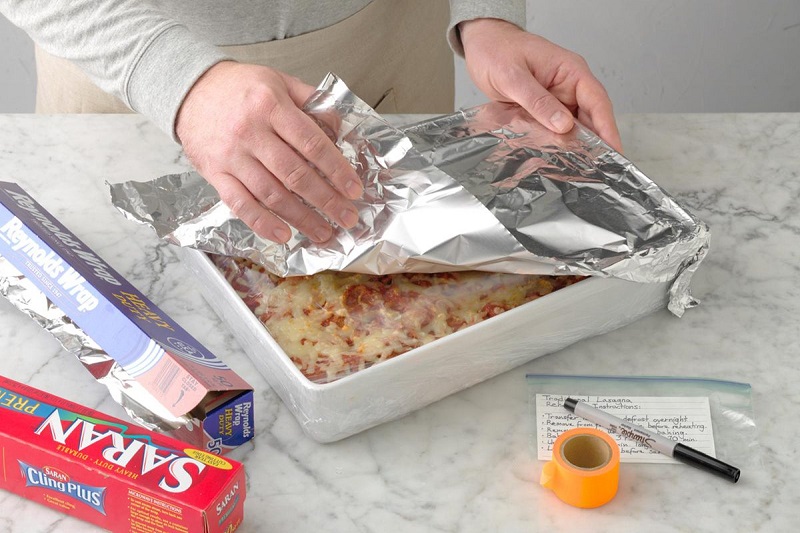Raw or cooked? In the fridge or freezer? Where to store them? There are many questions about how to store lasagna, but they will all have a precise answer.
To know how to store lasagna correctly, you need to make a few considerations: where would you like/need to store it? When would you like to eat them? What tools do you have at home? A dish, whether cooked or raw, shouldn’t be beaten in the cold and away: the risk of cross-contamination is very high if you are not organized… and this guide to get to the facts in the right way will be very useful to you.
Whole lasagna or in portions?
The lasagne can be preserved in both wholes and already in portions. You can therefore prepare trays already with the aim of not consuming them and keeping them for an important occasion, optimizing leftovers, or making them specifically and then dividing them into comfortable and individual portions (for lunch at the office, or at university, for example). The only necessary condition to avoid making mistakes is that the lasagna – whole or in portions – is at room temperature before refrigerating it.
Conservation in aluminum trays or special containers?
Conservation is a serious matter, even when there is cold or frost to help us: it is important to be careful and use the tools we have available well. If we freeze the lasagna by wrapping it in plastic wrap, take care to make double layers with baking paper at the base, and then line everything with aluminum foil; if you use the classic disposable trays then close them and then wrap them further in aluminum or food film; the special containers for the freezer are also ideal for the refrigerator, even better if equipped with an airtight closure with a valve.
In the refrigerator from raw
We have busy lives between work and various activities, it’s not easy to block an entire day to cook if we have dinner with friends or relatives. How to do it then? Necessarily, in the previous days we begin to prepare something and the dishes that are cooked in the oven – such as lasagna – lend themselves well to the purpose. Lasagna is almost always made a couple of days before the event and most people layer it in the pan and then refrigerate it uncooked and cook it to order. That’s fine, but pay attention to the times: lasagna is full of butter, fresh dairy products, and probably meat… they can’t lie forever in these conditions. Cook them, therefore, within 2 days at the latest.
In the refrigerator to cook
Another solution is to get one more thought out and cook the lasagna so that you only have to heat it up the night you need it. Also in this case they can be kept in the refrigerator, when cooked, whole, or sliced. As already mentioned, be careful not to refrigerate them when hot and not to package them when hot. It doesn’t matter whether you use aluminum trays or cling film or airtight containers: bring the lasagna to room temperature and, only now, pack it and put it in the fridge. The resistance times do not change for 2-3 days maximum. If you don’t expect consumption within these terms then freeze them but try not to wait for the last second.
Vacuum packed
An excellent storage method is vacuum packing, which works perfectly by extending the natural life of the lasagna by up to a week. If you want to use vacuum bags, which hardly exceed a certain size, then you should have cooked and already portioned lasagna. If you want to use containers suitable for vacuum then you can also keep them whole: the size of these containers varies and they are equipped with a valve to connect the vacuum machine. Only in this second case can you think of keeping them raw, even if it could prove difficult to transfer them to the pan to cook them.
In the freezer (raw or cooked)
For the freezer, exactly the same rules explained above regarding storage in the refrigerator apply: you can keep them raw, cooked, whole, in portions… provided that the lasagna is placed in special containers and at room temperature. Once the vacuum has been obtained, you can then transfer that too to the freezer in case you don’t intend to consume the meal within a week. The only difference between keeping in the fridge and this is the expiry date: no longer 2-3 days but 2-3 months in optimal conditions.
If you decide to freeze raw lasagna, you then have two solutions: either let them come to room temperature the night before (transferring them from the freezer to the refrigerator) and cook them or put them in the oven and cook them from frozen.
In the blast chiller
More and more people are choosing to invest in a blast chiller, i.e. a forced air freezer that can reach temperatures down to -40°C. The best thing about this accessory is that it blasts the temperature in a very short time: if a lasagna at room temperature takes hours and hours to freeze in the freezer, the times are halved in the blast chiller and without the formation of ice crystals on the surface.
